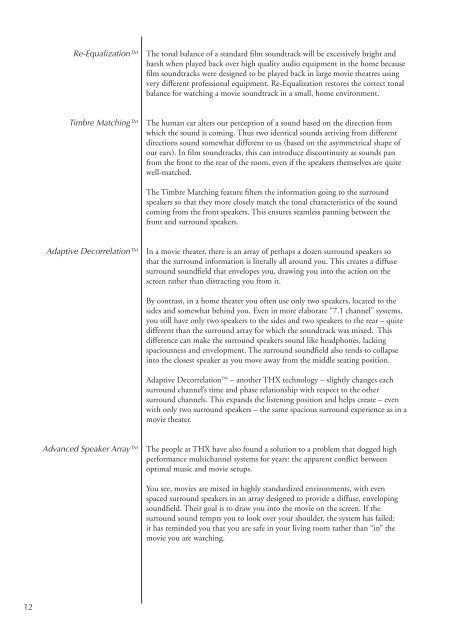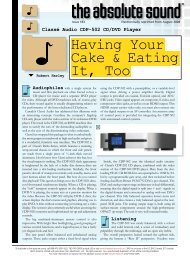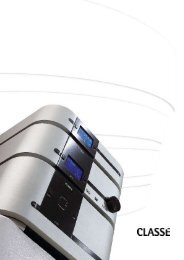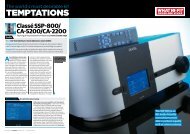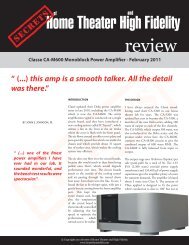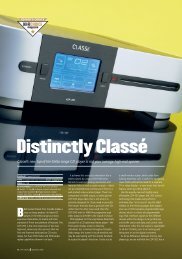Owner's Manual SSP-600 Surround Processor - Classé Audio
Owner's Manual SSP-600 Surround Processor - Classé Audio
Owner's Manual SSP-600 Surround Processor - Classé Audio
You also want an ePaper? Increase the reach of your titles
YUMPU automatically turns print PDFs into web optimized ePapers that Google loves.
Re-Equalization<br />
The tonal balance of a standard film soundtrack will be excessively bright and<br />
harsh when played back over high quality audio equipment in the home because<br />
film soundtracks were designed to be played back in large movie theatres using<br />
very different professional equipment. Re-Equalization restores the correct tonal<br />
balance for watching a movie soundtrack in a small, home environment.<br />
Timbre Matching<br />
The human ear alters our perception of a sound based on the direction from<br />
which the sound is coming. Thus two identical sounds arriving from different<br />
directions sound somewhat different to us (based on the asymmetrical shape of<br />
our ears). In film soundtracks, this can introduce discontinuity as sounds pan<br />
from the front to the rear of the room, even if the speakers themselves are quite<br />
well-matched.<br />
The Timbre Matching feature filters the information going to the surround<br />
speakers so that they more closely match the tonal characteristics of the sound<br />
coming from the front speakers. This ensures seamless panning between the<br />
front and surround speakers.<br />
Adaptive Decorrelation<br />
In a movie theater, there is an array of perhaps a dozen surround speakers so<br />
that the surround information is literally all around you. This creates a diffuse<br />
surround soundfield that envelopes you, drawing you into the action on the<br />
screen rather than distracting you from it.<br />
By contrast, in a home theater you often use only two speakers, located to the<br />
sides and somewhat behind you. Even in more elaborate “7.1 channel” systems,<br />
you still have only two speakers to the sides and two speakers to the rear – quite<br />
different than the surround array for which the soundtrack was mixed. This<br />
difference can make the surround speakers sound like headphones, lacking<br />
spaciousness and envelopment. The surround soundfield also tends to collapse<br />
into the closest speaker as you move away from the middle seating position.<br />
Adaptive Decorrelation – another THX technology – slightly changes each<br />
surround channel’s time and phase relationship with respect to the other<br />
surround channels. This expands the listening position and helps create – even<br />
with only two surround speakers – the same spacious surround experience as in a<br />
movie theater.<br />
Advanced Speaker Array<br />
The people at THX have also found a solution to a problem that dogged high<br />
performance multichannel systems for years: the apparent conflict between<br />
optimal music and movie setups.<br />
You see, movies are mixed in highly standardized environments, with even<br />
spaced surround speakers in an array designed to provide a diffuse, enveloping<br />
soundfield. Their goal is to draw you into the movie on the screen. If the<br />
surround sound tempts you to look over your shoulder, the system has failed:<br />
it has reminded you that you are safe in your living room rather than “in” the<br />
movie you are watching.<br />
12


